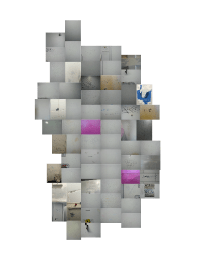Over the past few years I have been turning my attention towards toilets both as a research interest, a space for activism, a workplace, a space for exploring and undoing gender, making art, escaping toxic institutions, recognising my privilege, and thinking about the spatial politics of accessibility and inclusion. Whilst at Goldsmiths from 2015 – 2017, I have been quietly observing how the toilets on campus are also a space for writing, speech, exposure and dialogue, through the use of toilet graffiti writing or ‘latrinalia’. On reading Nirmal Puwar’s paper on the ‘archi-textures’ of parliament (2010) in preparation for participating in her Feminist Methods Masterclass, I was struck by Puwar's re-telling of the story of Marion Wallace-Dunlop, a Suffragette, who was imprisoned for stencilling sections of the Bill of Rights onto the walls of the entrance to parliament. Interestingly, and unsurprisingly, Wallace-Dunlop’s graffiti has long been removed from the walls of St Stephen’s Hall, like Wallace-Dunlop herself, who was charged and imprisoned on 25 June 1909. This made me wonder how we can do an archaeology of things which have been institutionally erased (an ‘archaeology of silence’? [Boyne 1990: 58]). What are the traces of this erasure? Whose labour is used? And how can we speak / write about / document this process without doing further violence, appropriating narratives or explaining away? Bringing these questions from the walls of parliament to Goldsmiths’ toilets is not such a radical departure… Aside from a shared language of ‘chambers’, ‘privies, ‘the throne’ etc. these spaces both share the ability to make writing disappear from walls.
Letting Slip
I decided to start photographing toilet graffiti at Goldsmiths after coming across the words: ‘where is Sara Ahmed?’ scrawled with urgency in red inside a library toilet cubicle. On returning a couple of days later with my camera to document the graffiti, I found that the writing had disappeared – I checked a few cubicles in case I had misremembered where it was, but all I could find was a pink-ish smudge. I didn’t take the picture at first, because it seemed pointless to take a photograph of something which seemed to be no longer there. I then went in search of other latrinalia (perhaps hoping/ expecting to find more political and pertinent writings), in one morning / afternoon, I covered almost every cubicle across a large majority of Goldsmiths’ female, gender-neutral/ accessible toilets, and some male labelled toilets (see photographic transcript here). Over the following weeks, I have returned to certain locations to photograph and make notes on the changing content of the graffiti, also asking other students to send me their graffiti photos. Mostly these are photographs of the faint remains / traces of half scrubbed and painted over words, letters scratched into the textures of the walls and doors and some reoccurring tags. In taking and collecting these photos, my attempt was to capture what these writings/ images do (Rose 2012: 17, Coleman 2009), and the feeling of looking at something which is both there and not there (Ahmed 2017). Texts which comprise letters but also the markings of cleaning products, and paint jobs, and therefore are sites of dialogue, loss, failure / slippage and perhaps conflict; texts which have multiple authors. Beginning my trail with the disappearance of the question ‘where is Sara Ahmed?’, brought to mind accounts I had heard about latrinalia at Goldsmiths from 15 or 20 years ago, which let slip about what is now understood as sexual harassment in the institution.
Goldsmiths (alongside many other higher education institutions) has become notorious for its silencing and covering up of complaints about sexual harassment over the years, through non-disclosure agreements and financial settlements. Graffiti such as this within the toilet could be read as signalling a hermeneutic marginalisation and isolation of individuals who have experienced sexual harassment (Fricker 2007: 153-4). What could not be spoken about and dealt with openly in the institution, is transformed into words, ‘rumour’ and markings on a toilet wall; a boundary where the private and public overlap, demarcating a space where things which are perceived as unpleasant or threatening can be made to disappear. According to Marion Fricker, hermeneutic injustice is:
‘The injustice of having some significant area of one’s social experience obscured from collective understanding owing to persistent and wide-ranging hermeneutical marginalisation’ (2007: 154)
It was because of this injustice, inflicted by the institution on victims of sexual harassment, that Professor Sara Ahmed publically resigned from her post at Goldsmiths last year. Speaking at a conference about her decision to leave, Ahmed said that ‘sometimes you have to disappear in order to survive’. Ahmed’s disappearance also drew attention to the way in which removing ourselves from institutions can have the power of bringing something else into view. She urges us to seek ways of leaving traces which make visible things which might otherwise be erased. Over the weeks of documenting the Goldsmiths toilets, the ‘where is Sara Ahmed?’ graffiti returned in several locations, as well as in interventions outside the university.
Were the anonymous writer(s) of these messages responding to Ahmed’s call to leave traces? And, to quite literally make visible the ‘institutional walls’ that she speaks about, through marking or ‘scratching’ at their surfaces? By rendering a question about Ahmed’s absence as this trace, does this then have the effect of making ‘those who identify a problem the location of the problem’ (Ahmed 2017)? Is it possible to know or assume the intention of an absent author, even in cases such as these where the micro examples seem to fit neatly inside a broader narrative of the exposure of sexual harassment in universities? Can this example be used to represent the meaning and place of toilet graffiti at Goldsmiths more broadly? What are the ethics of photographing and presenting speech / words which have been separated from their authors? Should consent be obtained to document these words? And from whom / how? In doing this I have made an assumption that, because of their location in a public toilet or around the school, these words were meant to be read, responded to and remembered. But what about the numerous other writings which speak of everyday things, jokes, banal or offensive comments or are indecipherable or ‘untranslatable’ (Spivak 1988: 1461)?
In her lecture Tiffany Page has talked about the difficulty of interpreting someone’s actions and intentions, especially when research subjects are no longer around to respond. Drawing on Elizabeth Freeman’s work, Page also warned against ‘solving problems ahead of time’, something which this first reading of graffiti as exposure (letting something slip), or resistance against an institution perhaps does. Saba Mahmood (2001) points to the tendency in liberal western feminism to frame social dynamics in terms of ‘resistance to relations of domination’ (Mahmood 2001: 203), and to only recognise actions which can be made to fit neo-liberal scripts of ‘agency’, ‘freedom’ and ‘emancipatory politics’, thus feeding a liberal western fantasy of ‘saving’ an oppressed ‘Other’ (Abu-Lughod 2002 :789). This hermeneutic tendency is heavily implicated in imperialism and colonialism (Smith 1999: 2; Spivak 1988: 1457) and commits what has been referred to as ‘epistemic violence’ (Spivak 1988: 1441 & 1448) or ‘epistemic injustice’ (Fricker 2007; Page 2017 b). When doing this kind of analysis we miss out on alternative, historically and contextually specific expressions of agency such as docility, perseverance, patience, responsibility, and ethical conduct which Mahmood writes about following her study of the women’s mosque movement in Egypt (2001: 220-3). What about the agency of the university’s facilities staff, cleaners, and their tools, audiences, walls, images, and archi-textures? Re-reading Gayatri Spivak’s important essay ‘Can the Subaltern Speak?’ has raised some important and unresolvable issues about the extent to which any kind of analysis or representation of writings and voices under-erasure is appropriate. Spivak says that the academic search for speech is an attempt to represent, and speak on behalf of the subaltern (1988: 1444). And that:
‘The intellectuals… become transparent in the relay race, for they merely report on the nonrepresented subject and analyse (without analysing) the workings of (the unnamed subject irreducibly presupposed by) power and desire’ (Spivak 1988: 437).
This calls for me to think reflexively about the ethics of this project, and to face my own uncertainty about whether it symbolically replicates epistemic violence (the will of the researcher to appropriate marginal voices and find someone, anyone to speak on behalf of, further erasing those voices in so doing), or can be seen as attending to the ‘words of others struggling to be heard’ (Lorde 2007: 43), which Audre Lorde articulates as part of a shared responsibility to ‘transform silence into language and action’ (2007: 42). Perhaps it is both, or neither, perhaps this tension shows a slippage between different feminist approaches to being in the world, both of which must surely be able to co-exist. Furthermore, this difficulty in interpreting/ giving an account of my own actions and intentions serves as a reminder of the impossibility of claiming to understand those of anyone else.
My harnessing of the concepts of ‘slipping’ and ‘slippage’ as a ‘feminist figuration’ (Braidotti 2011 cited in Neimanis 2013: 26) here, perhaps allows for a kind of ‘neither or both’ position and suggests an alternative type of standpoint to that of power and resistance, agreeing or disagreeing, succeeding or failing. A position that is consciously unstable and says ‘let’s slip!’

